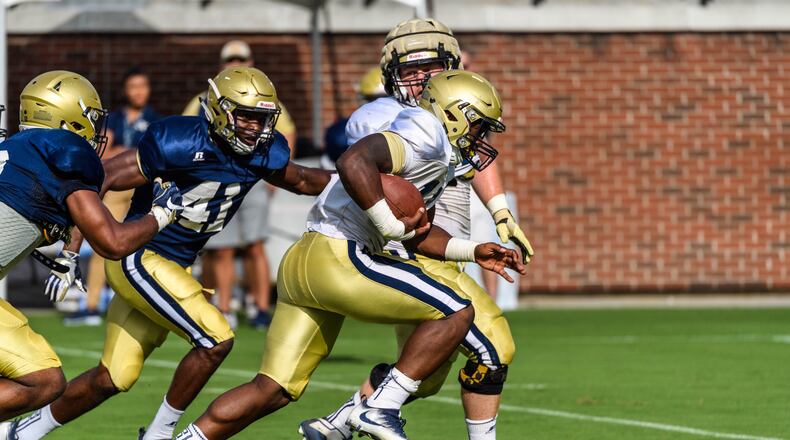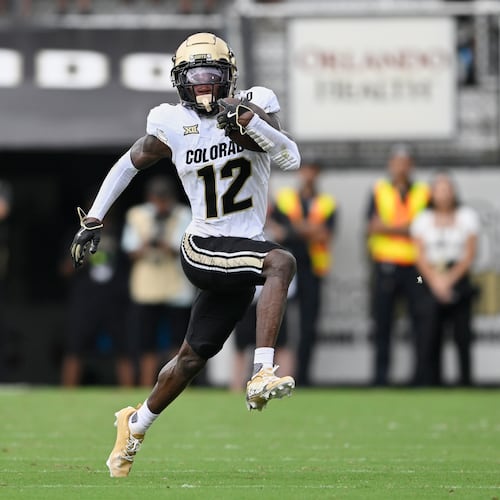Georgia Tech coach Paul Johnson isn’t joining the fans despairing over the loss of B-back Dedrick Mills. Following his team’s scrimmage Saturday morning at Bobby Dodd Stadium, he offered confidence in Mills’ backups and his offense in the wake of Mills’ dismissal from the team for violating athletic-department policy.
“You’d like to have the best player, but I’m not going to rush home and get in a closet and shoot myself,” Johnson said. “We’ve got guys that can play.”
In Johnson's first nine seasons, the fewest yards that Tech B-backs have gained as a group is 1,175. That was in the 2011 season, with David Sims and Preston Lyons taking a large majority of the carries. Most seasons, it has been significantly more. The high was achieved in 2014, when Synjyn Days, Zach Laskey and Matt Connors piled up 1,888 yards in Tech's 11-3 season. The more agonized Yellow Jackets fan might remember that the B-back position that season was cloudy going into the preseason after highly touted freshman Travis Custis – described then by star defensive tackle Adam Gotsis as "an animal" – left school in May with academic issues.
“Historically, find me a year where the guy who played that position didn’t have a lot of yards,” Johnson said.
Perhaps the weakest season for a starting B-back was Sims in 2012, when he started seven games and rushed 135 times for 612 yards for four touchdowns. His long rush was 19 yards. But it wouldn’t be unreasonable to expect one of the four players vying for the starting job – or the group as a whole – to achieve more this season, particularly with an offensive line that is seen as a strength.
KirVonte Benson, Jerry Howard, Quaide Weimerskirch and Jordan Ponchez-Mason are competing. Johnson said Friday that Benson would be the No. 1 if he weren’t out with an injury. He did say he expected him back Monday.
“Everybody talks about how little he is, but he’s about 215 (pounds),” Johnson said of Benson, who is 5-foot-9. “Really strong. Pretty fast, probably the fastest at that position. He’s got ability. Now, what’s he going to do when he gets out there?”
Howard has made an impression on Johnson in preseason practice. He called him a "load" and "hard to tackle" after the team's first scrimmage Aug. 12. Ponchez-Mason was splitting practice time at A-back and B-back earlier this week before the Mills dismissal moved him back to B-back full-time.
The other concern besides any of the four being able to approach Mills’ production is their experience level. Howard and Ponchez-Mason are freshmen. Benson and Weimerskirch are sophomores with one career rushing attempt between them. Not counting Johnson’s first season in 2008, it’s the fewest number of career carries that have been carried forward at the B-back position from one season to the next in Johnson’s tenure.
Asked if he felt comfortable with playing Howard in the season opener against Tennessee on Sept. 4 in the Chick-fil-A Kickoff game, Johnson responded, “Comfortable or not, he’s going to play.”
A frequent challenge for young B-backs is learning the pass-protection aspect of the position. Often, B-backs did not have to pass block much in high school. Also, at B-back, they line up with a hand on the ground and have to scan the defense before the snap from a low stance. A B-back will have to listen to the offensive line’s calls to know who to block if the defense shifts. And, finally, the blocking technique has to be right.
“You’ve kind of got to be aware at all times,” Days said. “I’d say the biggest thing is the O-line and their calls.”
With the star no longer on the roster, that learning takes on greater urgency with the season opener against Tennessee two weeks from Monday.
“I hope they’re not learning which direction (to go), but there’s intricacies that happen sometimes that, the more you play, the more it just naturally comes,” Johnson said. “But it’s our job to coach ’em and get ’em ready to play.”
Keep Reading
The Latest
Featured

